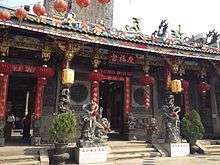Kheng Hock Keong
Kheng Hock Keong Temple (Chinese: 慶福宮; pinyin: Qìngfú Gōng; Pe̍h-ōe-jī: Khèng-hok-kiong; Burmese: ခိန့်ဟုတ်ဗုဒ္ဓဘာသာဘုရားကျောင်း), located on the corner of Sintodan Street and Strand Road in Latha Township, Yangon (Rangoon), Burma (Myanmar), is the largest and oldest Chinese folk religion's temple dedicated to the goddess Mazu in Yangon. It was originally built as a wooden temple in 1861 and completed in 1863.[1] A new brick building was completed in 1903, costing over 153,000 rupees.[1] Kheng Hock Keong is maintained by a Hokkien Chinese clan association.[2] The temple attracts mostly Hokkien and Hakka worshipers, while the other temple in Latha Township, called the Guanyin Gumiao Temple, attracts Cantonese worshipers.
Gallery
| Kheng Hock Keong after World War II, in 1945. |
| Kheng Hock Keong at 2013 Chinese New Year |
| Kheng Hock Keong at night |
|
References
- 1 2 Chen, Yi-Sein (1966). "The Chinese in Rangoon during the 18th and 19th Centuries". Essays Offered to G. H. Luce by His Colleagues and Friends in Honour of His Seventy-Fifth Birthday. Volume 1: Papers on Asian History, Religion, Languages, Literature, Music Folklore, and Anthropology (Artibus Asiae Publishers) 23: 107–111. JSTOR 1522640.
- ↑ http://www.chinatownology.com/kheng_hock_keong.html
See also







